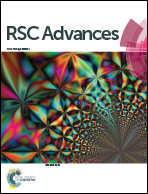Janus films with stretchable and waterproof properties for wound care and drug delivery applications†
Abstract
A commercial bandage provides a quick solution to small cuts and bruises by absorbing excess blood and covering the wound. In this study, we propose a type of medical dressing using a polydimethylsiloxane (PDMS) membrane with significant potential to improve wound healing conditions. A thin soft Janus PDMS film with opposing porous and nonporous faces is fabricated and tested for qualities applicable to improve current bandages, such as the porosity, stretchability, and water-wettability. The PDMS film can be stretched to 150% of its original length to allow the bending of fingers or joints. The nonporous face of the PDMS film provides a natural waterproofing barrier against intrusion by microbes and contaminants. The porous face of the bandage with pore size between 100 μm and 400 μm provides abundant void space for the preloading of pharmaceuticals and allows a relatively quick drug release (over 50% in 5 min, over 80% in 30 min), while simultaneously improving water vapor permeability. Blood absorbed could be distributed within the film's pore network, reducing the chances of forming a large clot and hardened scab that may break the wound bed upon removal. All these improvements demonstrate that the Janus PDMS film will provide the performance needs as a new bandage for wound care.



 Please wait while we load your content...
Please wait while we load your content...